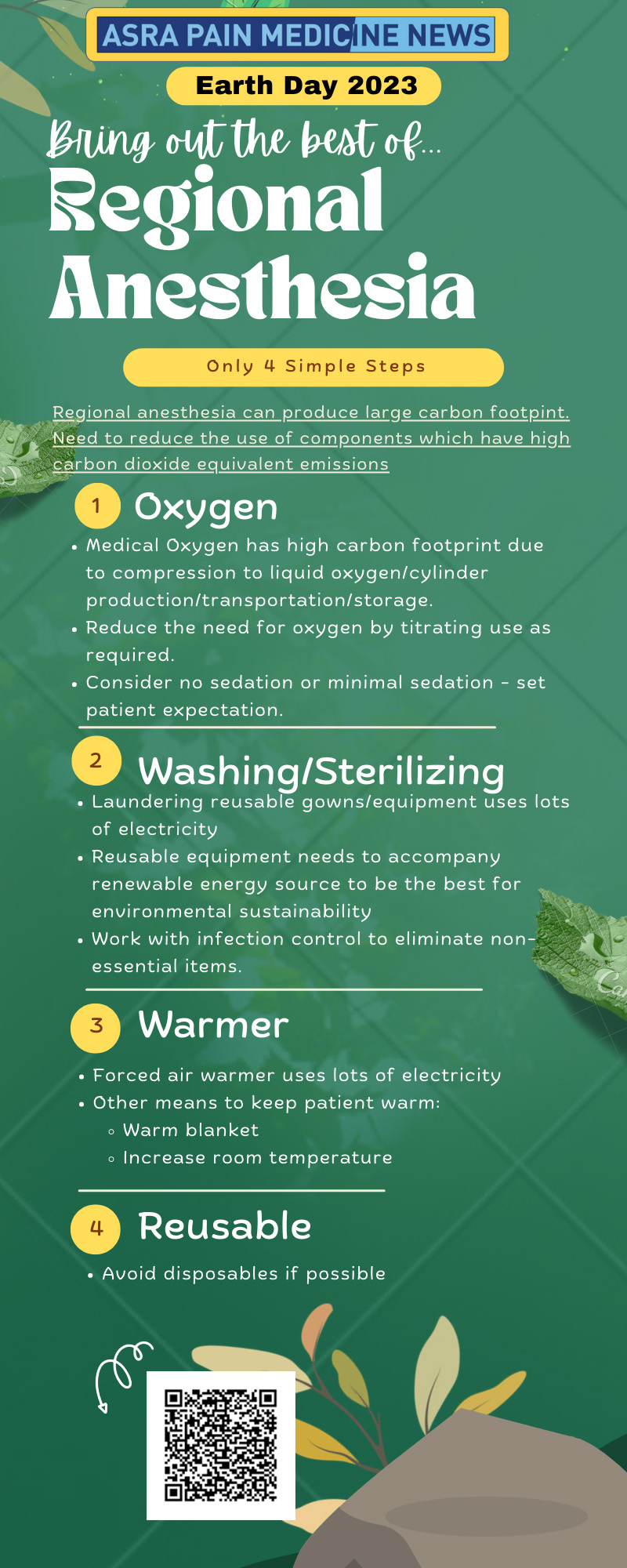Earth Day 2023: Bring Out the Best of … Regional Anesthesia
Cite as: Ip V, McGain F. Earth Day 2023: bring out the best of …. regional anesthesia. ASRA Pain Medicine News 2023;48. https://doi.org/10.52211/asra050123.013.
For this year’s Earth Day, the theme is to “restore our Earth.” As we edge closer to the global warming limit of 1.5° Celsius threshold, there needs to be a collective effort to reduce carbon dioxide equivalent (CO2e) emissions. We would like to present this infographic as a reminder that even though regional anesthesia is one of the strategies to minimize potent greenhouse gas by omitting/reducing the use of volatile agents, it can still produce a large carbon footprint from the various components used during the procedure as outlined in the observation study by McGain et al1, which is a prospective life cycle assessment of different types of anesthetic used for patients undergoing total knee replacement.
There were 10 patients in each of the three groups: general anesthetic, spinal anesthetic, and the combination of regional and general anesthetic. The CO2e emissions were examined in each group, and surprisingly, it was found that all anesthetic approaches had similar carbon footprints. On examination of the different components and their CO2e contributions, the high CO2e emissions in the spinal anesthetic group were a result of high-flow oxygen of 6L/min or more (2.8kg CO 2e emissions per patient). The electricity associated with the use of patient air warmers during the procedure was responsible for approximately 2.5 kg CO2e emissions per patient, and washing/sterilizing reusable gowns and towels produced 4.5 kg CO2e emissions per patient. Furthermore, the situation is compounded by the reliance on coal for electricity production in Australia where the study was conducted. In this infographic, we have outlined the strategies to ”Bring Out the Best of Regional Anesthesia.”
First, as medical oxygen is responsible for large CO2e emission due to its compression into liquid oxygen, one should reduce the use of oxygen by targeting oxygen therapy as required using oxygen saturation monitoring. Minimizing or omitting the need for sedation may eliminate the use of oxygen although this will require patient education and alignment of patient expectations preoperatively. Second, to be judicious with the use of reusable gowns and towels, the energy used to launder and sterilize reusable gowns can accumulate into large CO2e emissions. Therefore, renewable energy works synergistically with reusable garments and equipment. This may require a combined effort with infection control to examine robust evidence and formulate strategies to reduce carbon burden without causing harm. Third, warming patients during regional anesthesia performance can be accomplished without the use of forced air warmers. Lastly, avoid disposable garments if possible, as plastic waste will not transition our world to the land of low carbon! Join the committee for procurement and infection prevention!

Vivian Ip, MBChB, FRCA, is a clinical professor at the University of Alberta Hospital in Edmonton, Canada.
Forbes McGain, PhD, is an associate professor at University of Sydney and University of Melbourne in Australia.
Reference
- McGain F, Sheridan N, Wickramarachchi K et al. Carbon footprint of general, regional, and combined anesthesia for total knee replacement. Anesthesiology 2021;135:976-991. https://doi.org/10.1097/ALN.0000000000003967

